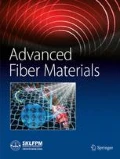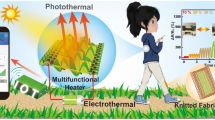Abstract
Wearable and portable electronic devices based on textile structure have been widely used owing to their wearability and comfortableness. However, yarn fineness and the comfort of the fabric cannot satisfy the requirements of smart wearable devices. This work presents a novel strategy to prepare highly integrated PVDF/conductive nylon core-sheath structure piezoelectric yarns for wearable which is fabricated by combining electrospinning strategy with 2D braiding technology. The fineness of single yarns as well as strength are both improved significantly compared to previous works. The piezoelectric outputs of the yarn are still stable after 800 s fatigue test at a frequency of 4 Hz, and the cycle stability can maintain more than 3200 cycles. Furthermore, the piezoelectric yarns are further woven into piezoelectric plain fabric. According to the electrical performance, the length of the piezoelectric yarn and the thickness of the piezoelectric layer would both affect the output electrical performance. The yarn of the 10 cm in length and 600 μm in fineness can produce an output voltage of 120 mV. Meanwhile, Both the piezoelectric yarn and the fabric could generate piezoelectric output signals through human movement, such as bending, walking. Therefore, the electrical and mechanical performance of the piezoelectric yarns prepared in our work could be improved significantly, and the comfortableness and durability performance of the piezoelectric fabric can satisfy most wearing requirements, which would provide some help in the field of piezoelectric wearable devices based on yarns and fabrics.
Graphical Abstract









Similar content being viewed by others
References
Sang M, Wang S, Liu S, Liu M, Bai LF, Jiang WQ, Xuan SH, Gong XL. A hydrophobic, self-powered, electromagnetic shielding PVDF-based wearable device for human body monitoring and protection. ACS Appl Mater Inter. 2019;11:47340–9.
Wang W, Cao J, Yu J, Liu R, Bowen CR, Liao WH. Self-powered smart insole for monitoring human gait signals. Sensors. 2019;19:5336.
Gao HP, Asheghali D, Yadavalli NS, Pham MT, Nguyen TD, Minko S, Sharma S. Fabrication of core-sheath nanoyarn via touchspinning and its application in wearable piezoelectric nanogenerator. J Text Inst. 2019;111:906–15.
Wang XW, Liu Z, Zhang T. Flexible sensing electronics for wearable/attachable health monitoring. Small. 2017;13:1602790.
Dong K, Peng X, Wang ZL. Fiber/fabric-based piezoelectric and triboelectric nanogenerators for flexible/stretchable and wearable electronics and artificial intelligence. Adv Mater. 2020;32:1902549.
Chen XL, Shao JY, An NL, Li XM, Tian HM, Xu C, Ding YC. Self-powered flexible pressure sensors with vertically well-aligned piezoelectric nanowire arrays for monitoring vital signs. J Mater Chem C. 2015;3:11806–14.
Shi Q, Sun J, Hou C, Li Y, Wang H. Advanced functional fiber and smart textile. Adv Fiber Mater. 2019;1:3–31.
Wang XX, Song WZ, You MH, Zhang J, Yu M, Fan ZY, Ramakrishna S, Long YZ. Bionic single-electrode electronic skin unit based on piezoelectric nanogenerator. ACS Nano. 2018;12:8588–96.
Yuan L, Fan W, Yang X, Ge S, Su SL. Piezoelectric PAN/BaTiO3 nanofiber membranes sensor for structural health monitoring of real-time damage detection in composite. Compos Commun. 2021;25:100680.
Huang R, Zheng SJ, Liu ZS, Ng TY. Recent advances of the constitutive models of smart materials—hydrogels and shape memory polymers. Int J Appl Mech. 2020;12:2050014.
Lee JH, Yoon HJ, Kim TY, Gupta MK, Lee JH, Seung W, Ryu H, Kim SW. Micropatterned P(VDF-TrFE) film-based piezoelectric nanogenerators for highly sensitive self-powered pressure sensors. Adv Funct Mater. 2015;25:3203–9.
Ai YF, Lou Z, Chen S, Chen D, Wang ZMM, Jiang K, Shen GZ. All rGO-on-PVDF-nanofibers based self-powered electronic skins. Nano Energy. 2017;35:121–7.
Chen YN, Feng RX, Li YS, Dan NH, Yang CK, Yu GF, Huang YP, Wen HT, Dan WH. Development and analysis of a novel PVDF membrane with higher content of beta phase. Int J Polym Anal Ch. 2019;24:684–95.
Jin L, Zheng Y, Liu ZK, Li JS, Zhai R, Chen ZD, Li Y. Design of an ultrasensitive flexible bend sensor using a silver-doped oriented Poly(vinylidene fluoride) nanofiber web for respiratory monitoring. ACS Appl Mater Inter. 2020;12:1359–67.
Mandal D, Henkel K, Schmeisser D. The electroactive beta-phase formation in Poly(vinylidene fluoride) by gold nanoparticles doping. Mater Lett. 2012;73:123–5.
Satyanarayana KC, Bolton K. Molecular dynamics simulations of alpha- to beta-poly(vinylidene fluoride) phase change by stretching and poling. Polymer. 2012;53:2927–34.
Wang WY, Zheng YD, Jin X, Sun Y, Lu BB, Wang HX, Fang J, Shao H, Lin T. Unexpectedly high piezoelectricity of electrospun polyacrylonitrile nanofiber membranes. Nano Energy. 2019;56:588–94.
Kim J, Byun S, Lee S, Ryu J, Cho S, Oh C, Kim H, No K, Ryu S, Lee YM, Hong S. Cost-effective and strongly integrated fabric-based wearable piezoelectric energy harvester. Nano Energy. 2020;75:104992.
Wu CM, Chou MH. Acoustic-electric conversion and piezoelectric properties of electrospun polyvinylidene fluoride/silver nanofibrous membranes. Express Polym Lett. 2020;14:103–14.
Yang E, Xu Z, Chur LK, Behroozfar A, Baniasadi M, Moreno S, Huang J, Gilligan J, Minary-Jolandan M. Nanofibrous smart fabrics from twisted yarns of electrospun piezopolymer. ACS Appl Mater Inter. 2017;9:24220–9.
Park S, Kwon Y, Sung M, Lee BS, Bae J, Yu WR. Poling-free spinning process of manufacturing piezoelectric yarns for textile applications. Mater Des. 2019;179:107889.
Ji SH, Cho YS, Yun JS. Wearable core-shell piezoelectric nanofiber yarns for body movement energy harvesting. Nanomaterials. 2019;9:555.
Kechiche MB, Bauer F, Harzallah O, Drean JY. Development of piezoelectric coaxial filament sensors P(VDF-TrFE)/copper for textile structure instrumentation. Sens Actuator A-Phys. 2013;204:122–30.
Qin Y, Wang XD, Wang ZL. Microfibre-nanowire hybrid structure for energy scavenging. Nature. 2008;451:809-U5.
Du YZ, Fu CK, Gao YZ, Liu L, Liu YW, Xing LX, Zhao F. Carbon fibers/ZnO nanowires hybrid nanogenerator based on an insulating interface barrier. RSC Adv. 2017;7:21452–8.
Martins P, Lopes AC, Lanceros-Mendez S. Electroactive phases of poly(vinylidene fluoride): determination, processing and applications. Prog in Polym Sci. 2014;39:683–706.
Karan SK, Bera R, Paria S, Das AK, Maiti S, Maitra A, Khatua BB. An approach to design highly durable piezoelectric nanogenerator based on self-poled PVDF/AlO-rGO flexible nanocomposite with high power density and energy conversion efficiency. Adv Energy Mater. 2016;6:1601016.
Kanik M, Aktas O, Sen HS, Durgun E, Bayindir M. Spontaneous high piezoelectricity in Poly(vinylidene fluoride) nanoribbons produced by iterative thermal size reduction technique. ACS Nano. 2014;8:9311–23.
Karan SK, Maiti S, Agrawal AK, Das AK, Maitra A, Paria S, Bera A, Bera R, Halder L, Mishra AK, Kim JK, Khatua BB. Designing high energy conversion efficient bio-inspired vitamin assisted single-structured based self-powered piezoelectric/wind/acoustic multi-energy harvester with remarkable power density. Nano Energy. 2019;59:169–83.
Lee BS, Park B, Yang HS, Han JW, Choong C, Bae J, Lee K, Yu WR, Jeong U, Chung UI, Park JJ, Kim O. Effects of substrate on piezoelectricity of electrospun Poly(vinylidene fluoride)-nanofiber-based energy generators. ACS Appl Mater Inter. 2014;6:3520–7.
Sun QL, Sun L, Wang FF, Gu H. Effect of hot-pressing on properties of Bubble-electrospun nanofiber membrane. Therm Sci. 2017;21:1633–7.
Figoli A, Ursino C, Ramirez DOS, Carletto RA, Tonetti C, Varesano A, De Santo MP, Cassano A, Vineis C. Fabrication of electrospun keratin nanofiber membranes for air and water treatment. Polym Eng Sci. 2019;59:1472–8.
Sheng JL, Zhang M, Xu Y, Yu JY, Ding B. Tailoring water-resistant and breathable performance of Polyacrylonitrile nanofibrous membranes modified by Polydimethylsiloxane. ACS Appl Mater Inter. 2016;8:27218–26.
Rodrigues A, Figueiredo L, Bordado J. Abrasion behaviour of polymeric textiles for endovascular stent-grafts. Tribol Int. 2013;63:265–74.
Uzun M, Govarthanam KK, Rajendran S, Sancak E. Interaction of a non-aqueous solvent system on bamboo, cotton, polyester and their blends: the effect on abrasive wear resistance. Wear. 2015;322:10–6.
Wortmann M, Frese N, Hes L, Golzhauser A, Moritzer E, Ehrmann A. Improved abrasion resistance of textile fabrics due to polymer coatings. J Ind Text. 2019;49:572–83.
Acknowledgements
The authors acknowledge the financial support from National Natural Science Foundation, China (Nos. 52073224, 51703179), National Key Research and Development Program of China (No. 2019YFA0706801), Innovation Capacity Support Plan of Shaanxi, China (No. 2020PT-043), Scientific and Technology Project for Overseas Students of Shaanxi, China (No. 12), Scientific Research Program Funded by Shaanxi Provincial Education Department, China (Grant No: 18JS041), and Thousand Talents Program of Shaanxi Province.
Author information
Authors and Affiliations
Corresponding authors
Ethics declarations
Conflict of interest
The authors declare that they have no conflict of interest.
Rights and permissions
About this article
Cite this article
Xue, L., Fan, W., Yu, Y. et al. A Novel Strategy to Fabricate Core-Sheath Structure Piezoelectric Yarns for Wearable Energy Harvesters. Adv. Fiber Mater. 3, 239–250 (2021). https://doi.org/10.1007/s42765-021-00081-z
Received:
Accepted:
Published:
Issue Date:
DOI: https://doi.org/10.1007/s42765-021-00081-z




